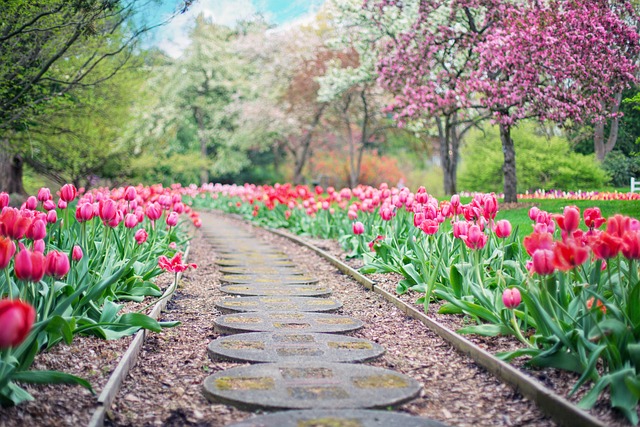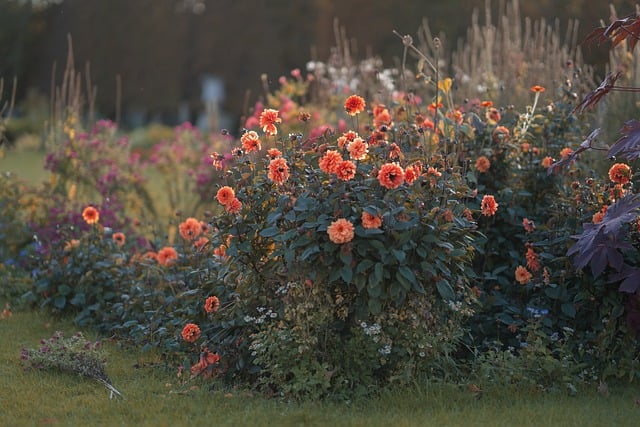Seasonal garden maintenance is essential for a thriving garden ecosystem. In spring, focus on clearing debris, dividing perennials, and fertilizing with balanced nutrients to kickstart growth. As summer approaches, implement early morning or late evening watering routines to conserve water and prevent root rot, using drip irrigation or soaker hoses for efficient application. Fall requires cleanup strategies such as cutting back perennials after the first frost, leaving spent plant material to enrich the soil, and applying mulch to protect plant roots from harsh winter conditions. Winter to early spring is the time for pruning, ensuring new growth has light and air, reducing disease risks, and preparing for the next cycle of growth. Throughout the year, tailor your fertilizing schedules to the needs of your plants, practice seasonal pest control, and use mulching as a strategy to adapt to seasonal changes, protect against extreme temperatures, and maintain soil health. By following these practices, you can ensure your garden remains resilient and vibrant throughout the seasons.
Gardening enthusiasts and seasoned horticulturists alike understand the significance of caring for perennials and annuals throughout their active cycles. A well-tended garden not only flourishes with vibrant blooms and lush foliage but also serves as a testament to the harmony between human effort and nature’s cycles. This article guides you through seasonal garden maintenance, emphasizing key practices that will ensure your perennials and annuals thrive from spring to winter.
We’ll explore optimizing your perennial beds, including early spring preparation, late spring bloom encouragement, mid-summer heatwave management, and fall cleanup strategies. Learn how to select and plant vibrant annuals for a colorful display, implement seasonal pest control measures, and understand the best watering tips for summer. Additionally, we’ll discuss fall fertilizing schedules, winter garden protection techniques, and the importance of pruning seasonal plants. Mulching practices are also highlighted as a year-round strategy to maintain soil health and enhance plant vigor throughout the seasons.
Whether you’re looking to revive dormant perennials, manage early growth spurts, or protect your garden from the elements, this comprehensive guide offers actionable advice tailored to each stage of the growing season. Embark on a journey to cultivate a thriving garden with our insights on seasonal garden maintenance, ensuring that your annual and perennial plants are not just surviving but truly flourishing.
- Optimizing Your Perennial Beds: Seasonal Garden Maintenance for Vibrant Plants
- – Early Spring Garden Preparation: Reviving Dormant Perennials and Setting Up for the Season
- – Late Spring Transition: Encouraging Blooms and Managing Early Growth Spurts
- – Mid-Summer Care: Watering Tips to Keep Annuals and Perennials Thriving Amidst Heatwaves
Optimizing Your Perennial Beds: Seasonal Garden Maintenance for Vibrant Plants

As the seasons transition, your perennial beds require specific care to thrive. In spring, begin with garden preparation by removing any debris or dead foliage from overwintering plants. This allows for ample sunlight and air circulation to promote healthy growth as temperatures rise. It’s crucial to prep your soil with a balanced fertilizer before the active growing season begins. This enriches the soil, providing the necessary nutrients for robust plant development.
Summer demands attentive watering; early morning is ideal to avoid evaporation. Consistent moisture is key, but be mindful not to overwater, as this can lead to root rot. Employ drip irrigation or soaker hoses to ensure efficient water usage and to minimize fungal diseases that thrive in damp conditions. As autumn approaches, prepare for fall cleanup strategies by cutting back perennials after the first frost to discourage pests from overwintering in your garden beds. This is also the time to remove any weeds and leave spent plant material to act as a natural mulch, which will enrich the soil over winter.
Winter protection varies depending on your region’s climate. In areas with harsh winters, consider applying a layer of mulch around sensitive perennials to protect their roots from extreme temperatures. For regions with milder winters, proper selection and placement of plants can mitigate the need for additional protection. As winter wanes and the threat of hard frosts diminishes, prune your perennials during early spring before new growth begins to appear. This allows light and air to penetrate the plant, reducing the risk of disease and promoting a healthy start to the growing season.
Seasonal pest control is an ongoing task that requires vigilance year-round. Monitor your plants regularly for signs of infestation, using appropriate, eco-friendly treatments as needed. By following a fertilizing schedule tailored to each season’s needs, you can ensure your perennials receive the correct balance of nutrients at the right time. This not only supports their growth but also helps them to withstand seasonal challenges and contribute to a vibrant garden throughout the year.
– Early Spring Garden Preparation: Reviving Dormant Perennials and Setting Up for the Season

As the days grow longer and the temperature begins to rise, gardeners turn their attention to spring garden preparation. This transitional period is crucial for reviving dormant perennials; it’s a time to clear away debris from the previous season and remove any dead or diseased plant material. Enriching the soil with compost and other organic matter at this stage not only provides essential nutrients but also helps in maintaining a healthy microbial environment, setting the foundation for vibrant growth. Additionally, it’s the ideal season to prune many perennials, as they are just beginning to awaken. This process encourages new growth and shapes plants to prevent congestion.
Moving into the active cycle of your garden, fertilizing schedules by season become pivotal for both perennials and annuals. Early spring is when you should start providing a balanced, slow-release fertilizer to promote strong root development. As the growing season progresses, adjust your fertilization routine to meet the specific needs of each plant type. For instance, summer watering tips recommend deep, infrequent watering to encourage deep root growth and drought tolerance. Meanwhile, preparing for fall cleanup strategies involves gradually reducing watering as plants go into dormancy and starting to think about winter garden protection. This might include mulching to insulate the soil and plant beds, which will help maintain even moisture levels and protect against extreme temperatures. It’s also the time to consider seasonal pest control measures, ensuring that your garden remains healthy throughout the changing seasons. Regular monitoring for pests and diseases will allow you to address issues promptly, preserving the beauty and productivity of your garden all year round.
– Late Spring Transition: Encouraging Blooms and Managing Early Growth Spurts

As late spring transitions into summer, gardeners must focus on maintaining their perennials and annuals to ensure healthy growth and abundant blooms. During this period, it’s crucial to monitor early growth spurts and provide adequate nutrients. Fertilizing schedules should be adjusted to meet the increased demands of plants in their active cycle. Utilize seasonal garden maintenance practices to encourage robust blooms by ensuring that soil pH levels are optimal for plant nutrition. Pruning during this time can also stimulate new growth and shape plants, improving overall health and aesthetics.
To manage early growth spurts effectively, consider the specific needs of each plant variety. For example, established perennials may require less frequent watering than newly planted annuals, which are more susceptible to drought stress. Implement summer watering tips that account for evaporation rates and rainfall patterns to conserve water without compromising plant health. As the season progresses, keep an eye out for signs of pests or diseases, employing seasonal pest control measures as needed to protect your garden’s vitality. Additionally, preparing for fall cleanup strategies early can help transition plants into the dormant season with minimal stress, setting them up for a successful winter garden protection phase. Mulching is an essential practice for managing seasonal changes, as it helps regulate soil temperature and moisture levels, reducing the need for frequent watering while insulating plant roots from extreme temperatures. Proper mulching also deters weeds and can aid in breaking pest life cycles, offering a multipurpose solution for maintaining a healthy garden throughout the year.
– Mid-Summer Care: Watering Tips to Keep Annuals and Perennials Thriving Amidst Heatwaves

During the heat of mid-summer, ensuring your annuals and perennials remain hydrated is paramount for their health and longevity. As temperatures rise, so does the demand for water. To combat this, consider the time of day you water; early morning or late evening are optimal to minimize evaporation. Deep, less frequent watering encourages deep root growth, making your plants more resilient to drought conditions. Additionally, employing a moisture-sensing device can help regulate water usage based on actual soil needs, rather than a fixed schedule, which is particularly useful during heatwaves.
When it comes to seasonal garden maintenance, spring garden preparation sets the stage for a thriving garden throughout the year. In spring, focus on clearing debris and weeds, as these can harbor pests and diseases. It’s also the ideal time to divide perennials that have outgrown their space, allowing them to flourish in new conditions. As part of your summer watering tips, remember that consistent hydration is crucial during this season when plants are actively growing. Fall cleanup strategies are equally important; remove dead foliage and leaves to prevent disease overwintering, and apply a layer of mulch to protect plant roots from extreme temperature fluctuations. This not only insulates the soil but also helps in maintaining moisture levels as we head into winter.
In preparation for the next growing season, fall is also the time for fertilizing schedules by season. Use a balanced, slow-release fertilizer to promote root growth and store nutrients for the dormant period ahead. Pruning should be done during the dormant season as well, which varies by region and plant type, allowing plants to heal before the next growing cycle begins. Finally, as winter approaches, implementing winter garden protection measures is essential. This can include evergreen boughs or nets to protect delicate shrubs and perennials from heavy snow and ice. For perennial beds, a thick layer of mulch will help shield plant roots from freezing temperatures, ensuring they emerge vigorously in spring.
Pruning seasonal plants should be done with care, considering the growth patterns and flowering times of each species to avoid stunting their growth or removing necessary structures for pollination. As part of your seasonal pest control, monitor your plants regularly, particularly during times of stress like extreme heat or cold. Early detection of pests can save your garden from extensive damage and ensure a healthy balance within the ecosystem of your garden. Mulching for seasonal changes is not only about temperature regulation; it also helps in retaining soil moisture, reducing weed growth, and improving soil quality over time. This holistic approach to seasonal garden maintenance will lead to a more resilient and beautiful garden year-round.
As the seasons cycle through the year, each brings unique demands and opportunities for caring for your perennial and annual plants. This article has provided comprehensive guidance on optimizing your garden’s health and beauty, from early spring preparations to meticulous summer watering tips, ensuring that your seasonal garden maintenance is up to par. Homeowners have learned essential pruning and fertilizing schedules by season, mulching strategies for managing soil temperature fluctuations, and fall cleanup strategies to prepare for winter’s chill. Additionally, understanding the importance of seasonal pest control has been highlighted as a critical component in maintaining a thriving garden ecosystem. By adhering to these guidelines, your perennials and annuals will not only survive but flourish throughout their active cycles, creating an ever-changing tapestry of color and life in your garden.
